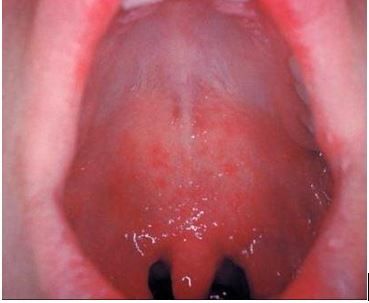This is Measles If You've Never Seen It
Here, the 5 key signs and symptoms that characterize measles in the order of appearance.
Would you know measles if you saw it? Could you put the signs and symptoms in chronological order of their appearance?
Answer
The incubation time for measles is about 8 to 12 days from exposure to onset of symptoms and this is the sequence to keep top of mind.
1. Fever and malaise appear first. In children, the temperature usually increases over the first several days to a high of 103°F to 105°F by day 4 or 5 and then falls quickly to normal.
2. Coryza, conjunctivitis, and cough appear second, usually within 24 hours of the onset of fever and peak at day 4 after fever onset. The cough will be the last symptom to disappear about 10 days after the onset of fever. The fever and conjunctivitis usually disappear about 6 days after the fever starts.
Koplik spots on the palate
(Courtesy of CDC)
(Courtesy of CDC)

3. Koplik spots appear first on the buccal mucosal about a day after the coryza and cough and 2 days after the onset of fever. The number of 1-mm in diameter, bright red spots with a bluish white center (think of a small grain of salt on a red background) increases to more than 100 spots that extend to the entire buccal and labial mucosa over 3 to 4 days. They then fade away in about 2 days or about 6 days after the onset of fever and about at the same time the fever dissipates.
Measles rash on torso after 3 days of infection
(Courtesy of CDC)
(Courtesy of CDC)

4. The rash first appears on the hairline of the face, including the forehead, behind the earlobes, and upper neck about 3 to 4 days after the onset of the fever. The prodromal period, however, can be as short as one day or as long as 7 days, but 3 to 4 days is more typical.
5. The rash then moves downward until it reaches the feet about 2 to 3 days after starting on the head. The upper body sites contain many more lesions that can become confluent, whereas the lower extremity lesions tend to be discrete and fewer in number. The rash leaves as it began, starting at the head and moving down. Initially it is maculopapular, blanching with pressure, but the rash can become non-blanching and brownish after 3 or 4 days. The duration of the exanthem is about 6 days.
To summarize, sudden onset of fever and malaise with the fever lasting 5 or 6 days peaking at day 4 to 5 with a rapid defervence. Koplik spots start a day or two before the rash and last about 4 days. The cough will be the last thing to go away, about 10 days after it starts. Infants may have diarrhea. Older children may develop a generalized lymphadenopathy, particularly in the postauricular, cervical, and occipital glands (typically the same glands that swell with rubella).
Newsletter
Enhance your clinical practice with the Patient Care newsletter, offering the latest evidence-based guidelines, diagnostic insights, and treatment strategies for primary care physicians.